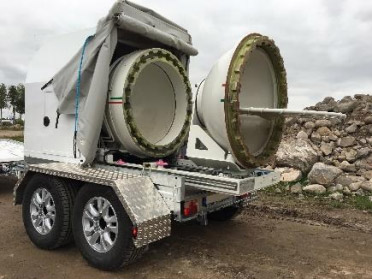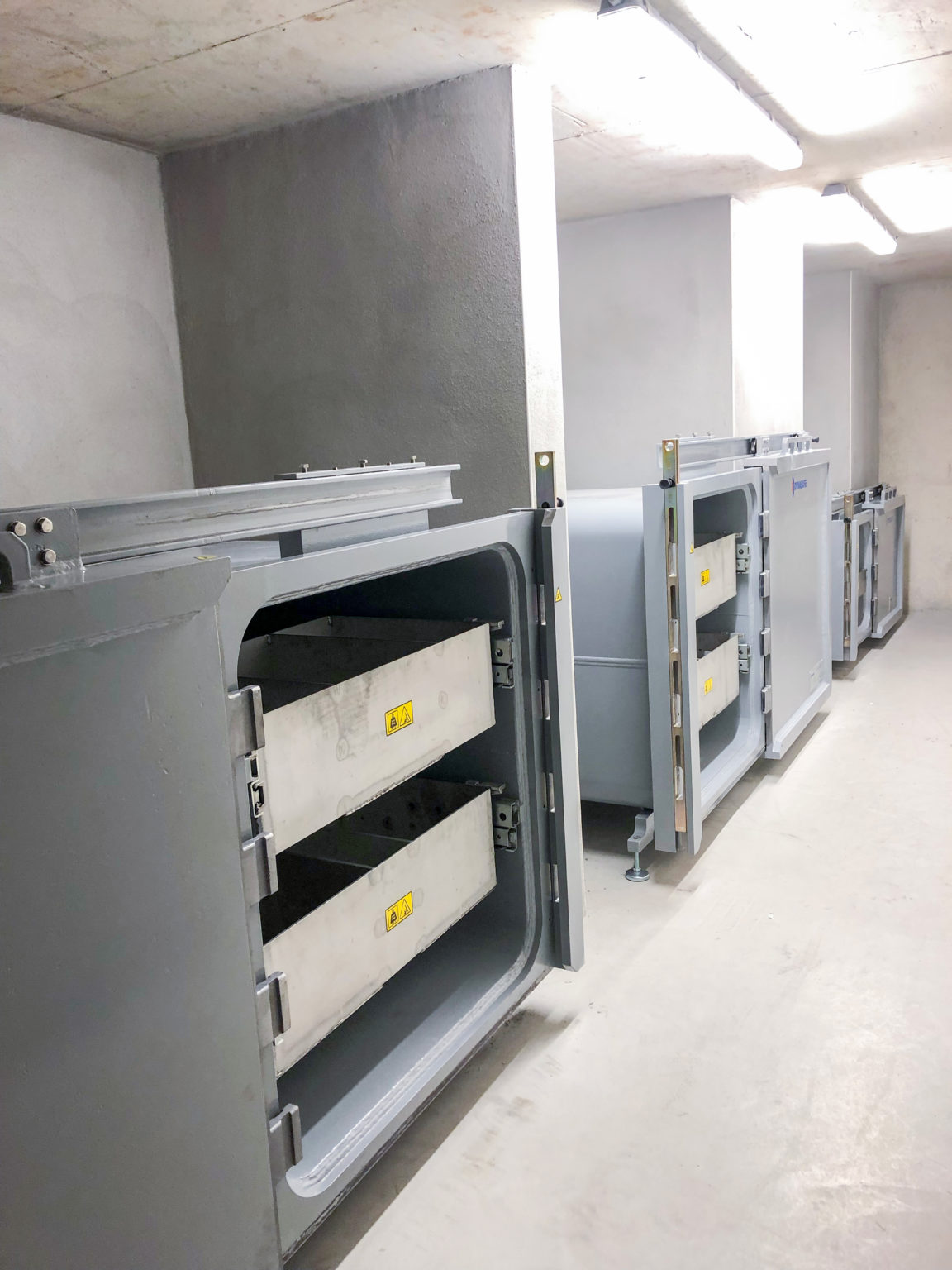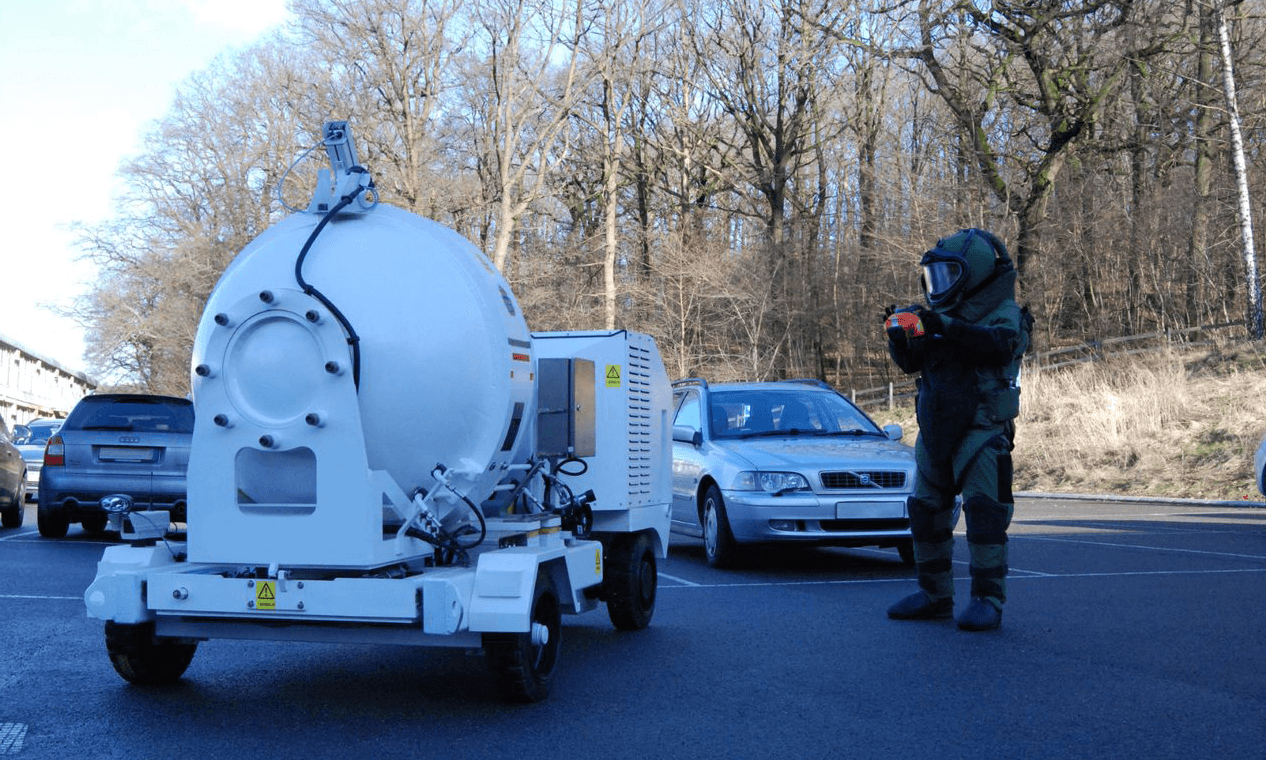Outlining Requirements for a Mobile Explosive Containment Vessel
April 25, 2019
Mobile Explosive Containment Vessels (MECV) also known as Total Containment Vessels (TCV) are fully enclosed vessels designed to safely secure, transport, and test explosive devices. MECVs are used by first responders, public security bomb technicians, and military EOD teams as explosive mitigation tools to help protect people and property from primary and secondary fragmentation debris and hazardous gases that are created from the detonation of an explosive device.
MECV’s are typically installed on a trailer or a truck for ease of transportation to the bomb threat location. Once the suspect package is contained in the chamber, the surrounding area is protected from the blast effects of the explosive device, up to the explosive rating of the chamber.
MECV Technology Overview
A MECV has four components: the explosive containment chamber, the gas-tight system, suspect package loading tray, and the frame holding the chamber. The chamber is typically spherical and made of high-strength steel from 25mm to 40mm thick. The chamber has an access door, an internal loading tray for holding the suspect packages, and a door locking system to keep the access door closed and gas-tight. Some MECVs have a protective layer of lead located between two layers of steel as a protective measure from radioactive materials, such as a dirty bomb.
All chambers are rated for a maximum internal blast pressure, which is called the trinitrotoluene (TNT) equivalent. The TNT equivalent for these vessels, typically measured in kilograms (kg), can range from 5 to 8 kg. A DDESB certified MECVs have a safety factor of 25% above the explosive rated capacity of the chamber. Therefore, if a chamber has a DDESB certification of 5 kg of TNT equivalent, its actual explosive rating is 6.25 Kg of TNT (5 kg + 25% X 5 kg = 6.25 kg)
The size and location of the vessel’s access door are important considerations. If the door opening is too small, the suspect object may not fit inside the vessel. If the door is in an inconvenient location, such as the top of the chamber, it may be difficult to access the explosive device for render safe procedure once it is in the chamber. Most chambers have side-loading openings ranging from 457mm to 1030mm in diameter. Some chambers have a door opening that rotates up to a radius of 270 ° to facilitate the loading of an IED or a suspect package.
A loading tray mechanism inside the chamber enables the smooth loading and unloading of suspect packages. Some chambers have a loading tray that is integrated into the door opening. The loading tray is automatically deployed when the door is opened with no operator interaction. The suspect package remains in the tray during transport.

DynaSEALR X10 mounted on a covered trailer
The capability of some MECVs to remain gas-tight is achieved in one of two ways. The first is a system consisting of two half-rings that tightly clamp together to hold the multiple rubber O-rings and the access door in a closed position. The clamping of the O-rings between the door and the chamber forms a pressurized seal resistant to high temperatures. The other system is to inflate pneumatic seals with 1000 PSI of nitrogen. The benefit of this approach is that the inflated pneumatic seal will expand and adhere to the contour of the chamber door and create an impermeable barrier to trap the hazardous gases generated from the explosion from passing into the environment.
The containment chamber is mounted on a steel or aluminum frame for support. The frame is designed to support one or two actuator button(s) for robot operation of the door, remote control, floodlights, and other equipment. It also accommodates a retractable all-weather aluminum cover, designed to provide protection from the elements and conceal the vessel from the public.
Applications
Explosive containment chambers have many applications in law enforcement, security, and transportation for safely securing, transporting, and testing explosive devices. Many governments and commercial office buildings, including embassies, nuclear power plants, airports, and other transportation facilities are prime targets for bomb threats. The MECV is designed to contain the bomb while being transported to an area where it can be rendered safe. Terrorist activities continue to escalate worldwide and MECVs are a great tool to meet bomb security needs.
Selection of a MECV
First Responder, and military or public bomb squads that consider purchasing MECVs should carefully consider each product’s overall capabilities and limitations in relation to their agency’s operational needs. Important mission-critical factors need to be considered when purchasing a MECV:
- What is the explosive rating needed to meet the mission-critical objectives? Is the maximum internal blast pressure of the chamber capable of mitigating and controlling a detonation of 5 kg of TNT equivalent? Is it 8 kg? more or less?
The larger the explosive rating, the safer it will be for the bomb technician and the area surrounding the suspect package. - Is the number of repeat detonations that a chamber can withstand more important to the EOD mission than a one-time blast capacity? There is a chamber that can contain the blast pressure of 20 kg of TNT from an improvised explosive device. Is the one-time blast capacity more valuable to the mission than a chamber that can withstand 10 repeat detonations of 8 kg of TNT?
A balance needs to be found between safety and the economics of utilizing a chamber for render safe procedures. As stated above, the larger the explosive charge that the chamber can contain, the safer it will be for the bomb technician and the area surrounding the suspect package. - What is the ideal door access diameter?
The bigger the diameter of the door access, the larger the suspect package that can be loaded. The quicker the suspect package can be loaded, the safer the bomb technician and the surrounding area. - What are the maximum object dimensions (mm/inches) that will fit onto the tray inside the core chamber?
- What are the test methods used to test and evaluate the chamber? Does the company utilize a third party to test their vessels? What type of tests are conducted? Is the chamber tested for its capability to contain gases after a detonation?
- Any explosive containment chamber that is for use in emergency situations where the threat is unknown should remain gas-tight at its maximum repeat detonation capacity. How long does the chamber remain gas-tight?
- What is the weight of the MECV? Will a dedicated vehicle or driver’s license be needed to transport the chamber?
- What is the weekly, monthly, or annual maintenance requirement of the chamber?
The fewer number of moving parts translates to reductions in required maintenance and more time dedicated to added value activities such as training.
Related articles
view allDynasafe contributes to public safety at All-Star Game
July 19, 2021Explosive Containment

Dynasafe announces the launch of the Q5 explosive containment chamber
May 15, 2021Explosive Containment
Dynasafe announces the launch of its DynaLOCKR F7 and F10 explosive storage chambers
April 16, 2019Explosive Containment
Dynasafe announces the launch of its DynaSEALR P6M explosive containment chamber
June 15, 2018Explosive Containment
DynaSEALR X 10 and DynaSEALR X 12 approved by DDESB
January 08, 2015Explosive Containment
Dynasafe makes an explosive appearance at Eurosatory 2014 exhibition in Paris
June 19, 2014Explosive Containment
Related articles

Dynasafe contributes to public safety at All-Star Game
July 19, 2021Explosive Containment

Dynasafe announces the launch of the Q5 explosive containment chamber
May 15, 2021Explosive Containment

Dynasafe announces the launch of its DynaLOCKR F7 and F10 explosive storage chambers
April 16, 2019Explosive Containment


